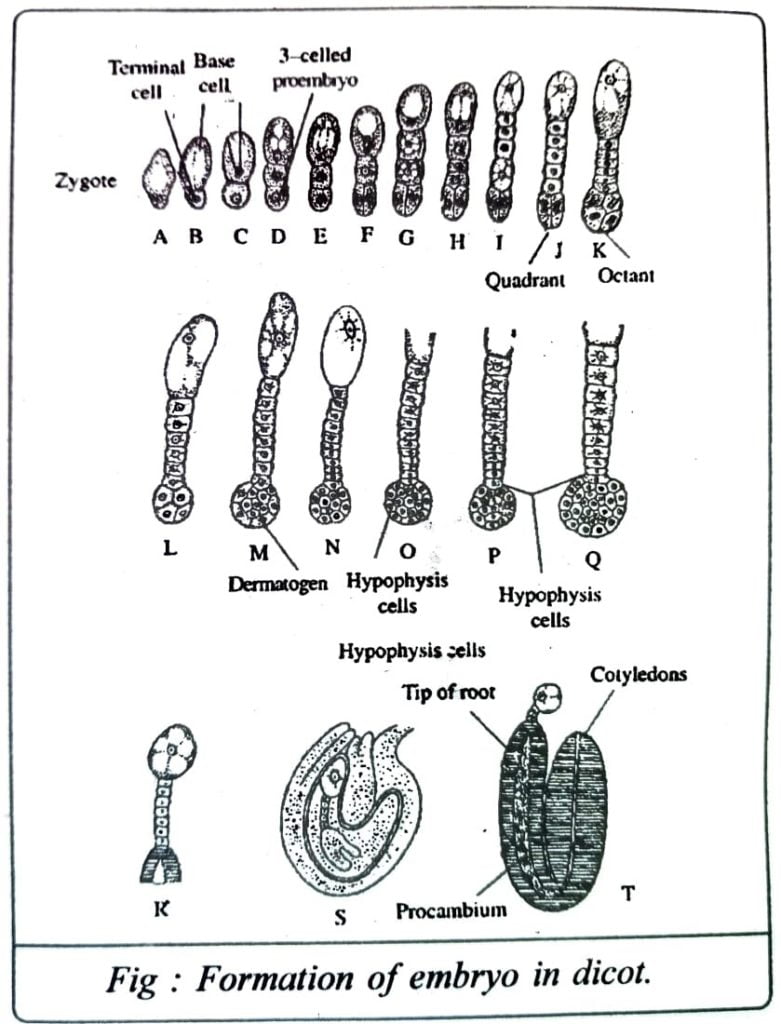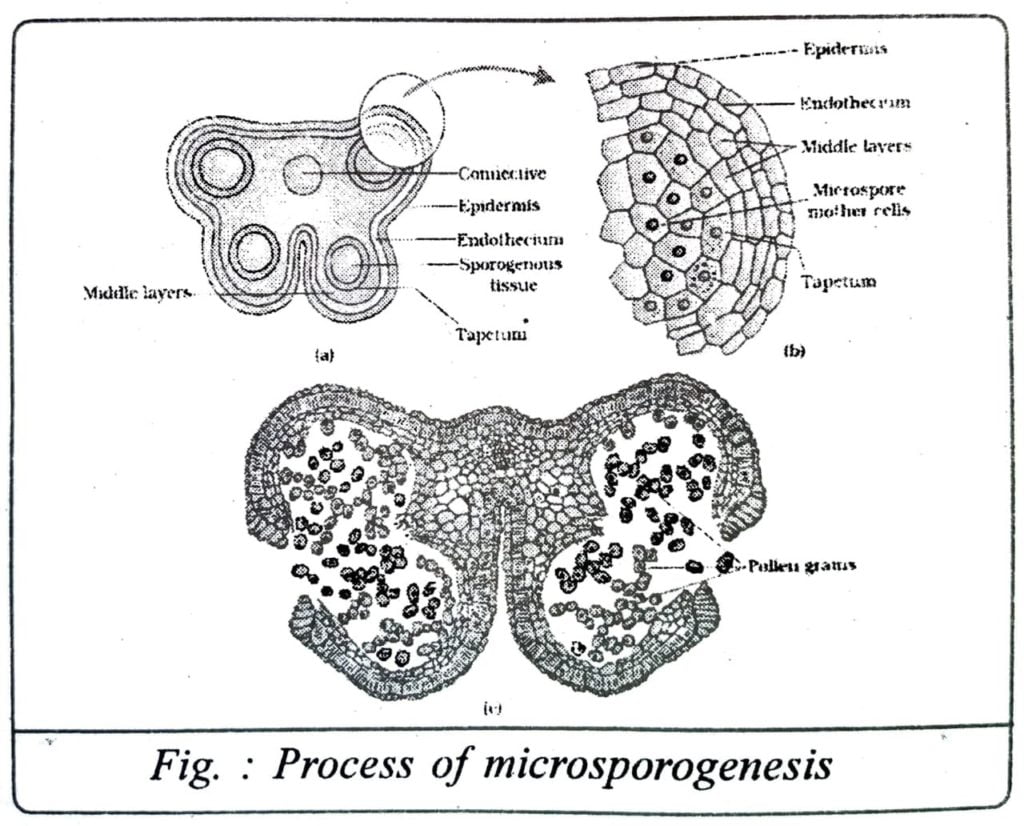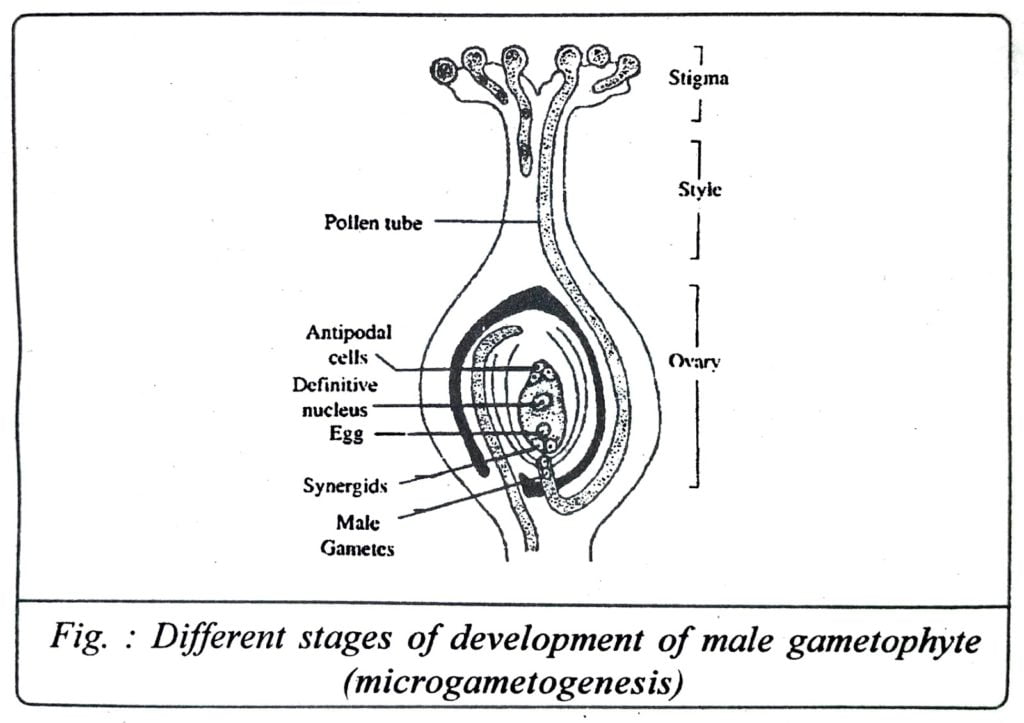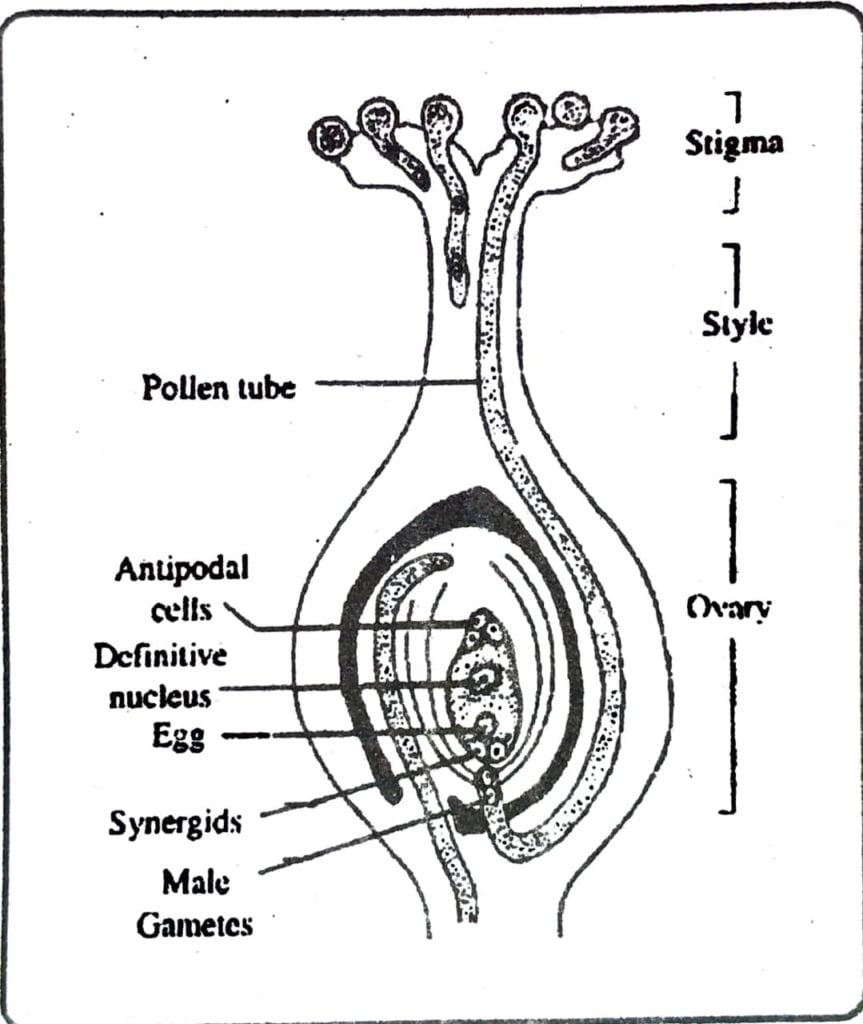Class 12 Biology Chapter 2 Sexual Reproduction in Flowering Plants The answer to each chapter is provided in the list so that you can easily browse through different chapters Assam Board HS 2nd Year Biology Chapter 2 Sexual Reproduction in Flowering Plants Question Answer.
Class 12 Biology Chapter 2 Sexual Reproduction in Flowering Plants
Also, you can read the SCERT book online in these sections Solutions by Expert Teachers as per SCERT (CBSE) Book guidelines. These solutions are part of SCERT All Subject Solutions. Here we have given Assam Board Class 12 Biology Chapter 2 Sexual Reproduction in Flowering Plants Solutions for All Subjects, You can practice these here.
IV.QUESTION FOR 5 MARKS (EXPLANATORY)
Q.1. What is embryo? Discuss the stages of development of a dicot embryo. How you can differentiate a dicot embryo from a monocot embryo?
Ans : Embryos are baby plants remain in dormant stage within the ovule. It has two axis called radicle and plumule. Radice give rise to future root system and the plumule given rise to future shoot.
Embryo Formation : The fertilized egg cell cloths itself with a cellulose wall and becomes a zygote or oospore. Now the oospore divides into two cells by a transverse wall. Of the two cells thus formed one is basal cell and the other is terminal cell. The basal cell divides in one direction to form an elongated structure called haustorial suspensor. The suspensor pushes the young embryo deep inside the embryo sac. The end cell of suspensor which is called basal cell of the suspensor remains bulbous and acts as absorbing organ for the growing embryo. The terminal cell which acts as embryonal cell first divides by two consecutive vertical division to form a four-cell structure called quadrant then by a transverse division the number of cells rises to eight.
This stage is called octant stage. The octant mass divides by a wall parallel to the curved surface forming a posterior or hyponasal octant and an anterior or epibasal octant. The epibasal cells by further differentiation form the plumule and cotyledons, while the parabasal cells form the hypocotyl. Plumule gives rise to shoot hypocotyl gives rise to radicle, the future root. The peripheral cells of the proembryo divide by a wall parallel to its curved surface. This layer of cells divide vertically and periblem (future cortex). The cells of the suspens or which is in contact with the embryo cell is called hypophysis. It forms the root. The embryo is further differentiated into cotyledons. The suspensor later degenerates and due to the curving of the ovule the embryo also becomes curved.
The process of embryo formation described above is of dicotyledonous seed. The process of embryo formation in monocotyledonous seed is almost similar upto octant, stage. Difference appears only in later stages during the formation of cotyledons. In dicots two cotyledons are formed and in monocots only one cotyledon is formed. While in dicots the opposite cells of the terminal quadrant take part in the formation of two cotyledons, in monocots, 2-4 terminal cells take part in cotyledon formation. The other terminal cells take part in shoot formation. In grass family (monocotyledon) the cotyledon is situated laterally. It called scutellum. In monocoty ledons, the radicle is enclosed by a sheath called coleorhiza, and plumule is enclosed by another sheath called coleoptile.

Q.2. ‘Incompatibility is as natural barrier in the fusion of gametes.” Justify the statement.
Ans : Incompatibility many occur due to many reasons. Sometime the microgamete and sometime macrogamete may be incompatible to each other or one or may be sterile. Sometime to prevent self pollination flowers adapt some contrivances so that only cross pollination takes place. These contrivanes are actually natural barrier which prevent self pollination. Thus the plant create self incompatibility. The natural barries one of various types such as unisexuality, self-sterility dichogamy, heterostyly, herkogamy etc. Of these unisexuality is the best adaptation of incompatibility. Because of incompatibility, cross-pollination occurs in most bisexual flowers.
This leads to exchange of genetic quality. Which causes improvement in the genetic quality of plants and leads to further evaluation.
Q.3. ‘Pollination is an important phenomenon in the life cycle of a flowering plant.’ Discuss the statement and describe briefly about the role of different agencies responsible for the events.
Ans : Without pollination fertilization cannot takes place. And without fertilization fruits and seeds are not formed. Therefore pollination is essential for not as production of fruits and seeds but also for continuity of species through sexual reproduction pollinations essentially a part of sexual reproduction is plants.
Pollination is the only method without which sexual reproduction cannot take place. Pollen Grains donate male gametes. The union of male and female gametes restore diploid chromosome number in a species. This is essential for continuity of the species. Pollen-grains reach the stigma by various methods devised suitably by each species.
Plants have evolved various mechanisms for carrying but pollination. Morphology of the flowers have been adapted according to the nature and morphology of the pollinating agents. Nature favours cross-pollination and therefore flowers adapt themselves in various ways so that various natural agents can help pollination, the natural agents involved in pollination are:
(i) Insect : Pollination done by insects is called entomophily and the insect pollinated flower is called entomophilous flowers. The insect loving flowers have various adaptation by which they attract insects and use them as conveyors of pollen-grains for pollination for insect pollination flowers must be.
(a) Conspicuousness : When flowers are small they aggregate into inflorescence to become conspicuous which then can attract insects.
(b) Coloured : Coloured and large showy flowers have great attraction for butterflies, bees and other types of insects.
(c) Have Nectar : Nectar has special attraction for bees. Many types of flowers are equipped with nectar glands which secret nectar at the base of the corolla.
(d) Scented : Nocturnal flowers generally emit sweet scent which (p) attracts insects at hight when colour fails to attract them.
(e) Have Sticky Pollen-grains : The pollen grains of entomophilous flowers are generally either sticky or are provided with spines so that the pollen grains can easily stick to the body of the insects and are then carried by them easily.
(ii) Wind : Pollination is brought about by wind in flowers which are (1) small and inconspicuous. They are not coloured or showy. Such flowers do not produce any scent or nectar.
(iii) Water : Pollen grains of aquatic plants may be carried by water current and may get in touch with the stigma at the surface of water. All aquatic pants are not hydrophilous. Hydrophily is but the rule in submerged plants. The submerged plants generally lift there female flower to the surface of water for pollination.
(iv) Animals : Pollination may be brought about by various animals. When pollination is done by bats it is called chiropterophily. Bombax, Bauhinia etc. plants are pollinated by bats. Pollination in plants like Erythrina, Bombax, Bignonia etc. are brought about by birds, squirrels etc. Pollination by birds is called ornithophily. Pollination in aquatics are caused by snails. Such pollination is generally called malacophily.
Q.4. Describe the sequence of the events that lead to the development of a 3 celled pollen grain from microspore mother cell in angiosperms.
Ans : The process of formation of male reproductive unit (microspore or pollen-grain) and female reproductive unit (megaspore) is called sporogenesis. Development of microspores is called microsporogenesis.
Each microsporophyll develops as a smail outgrowth known as microsporophyll primordium on the receptacle or thalamus. Due to apical growth it elongates and gets differentiated into filament and two anther lobes.
A transverse section through a young anther shows that it comprises of a homogeneous mass of cells limited by a well defined epidermis. The cells are meristematic in nature. A hypodermal layer having larger cells with dense cytoplasm and prominent nuclei forms below it. This layer is called archesporial layer. In archesporial layer four cells become very much prominent-one in each developing lobe. These cells are called archesporial cells. Each such cell divides by a periclinal wall (parallel to outer wall) forming an outer primary wall cell and an inner primary sporogenous cell.
The primary wall cell by periclinal and anticlinal divisions forms 2-6 layers of the wall of the microsporangium. The primary sporogenous cell by repeated division forms sporogenous mass. Of the concentric layers of the microsporangium wall the outermost one is called epidermis or exothecium and the innermost one is called tapetum. In between these two layers lies the endothecium. Tapetum is the nourishing layer which supplies nutrition to the sporogenous mass.
The Primary sporogenous cells are diploid (2n) which may undergo first a mitotic division to produce a large number of diploid nuclei or may directly behave as the microspore mother cell (MMC). Each MMC by meiotic division gives rise to four haploid microspores. Initially all the four microspores remain enclosed by a common wall. This four-celled structure is called tetrad. A mature microspore is called pollen- grain. As each MMC gives rise to four pollen-grains a large number of pollen-grains are produced inside the pollen-sac or microsporangium. All sporogenous cells may not function as MMC. Some may function as nutritive materials for growth of MMC.

Development of Pollen grain into Male Gametophyte :
(a) Pre-pollination Development : Microspore or the pollen is the first cell of the male gametophyte. The process of formation of male gametophyte starts with the division of the nucleus of the microspore which are still within the microsporangium. With the division of the nucleus into two the microspore also undergoes division into two cells. The larger one is called the vegetative cell or the tube cell and the smaller one is called the generative cell. Further changes in male gametophyte occur after pollination.

(b) Post-pollination Development : After pollination, the pollen grains are stimulated by the secretion of the stigma to germinate. At the time of germination the exine breaks and the intine forms pollen tube. The vegetative nucleus now enters the pollen tube. It is now called tube-nucleus. The generative nucleus also enters the pollen tube and divides to form two nuclei before the tube reach micropyle. These two nuclei are called male gametes. The tube nucleus ultimately degenerates. The male gametes are now ready to unite with the egg formed by the process of megagametogenesis. In 70% plants post-pollination development takes
place. The remaining plants, the generative nucleus divides into two male gametes of microgametes before the pollination take place.
Q.5. What is allogamy? Discuss the contrivances of allogamy stating the most convenient method of achieving allogamy.
Ans : Allogamy is the transfer of pollen grains from one flowers to another flower of the same or different plants. The flowers involved are bisexual flowers. The type of pollination is called cross Pollination. Nature favours cross-pollination and therefore to avoid self-pollination flowers and apt various ways, that is to say some favour able conditions called contrivances are created so that only cross pollination takes place.
The contrivances are :
(i) Dicliny or Unisexuality : In unisexual flowers the stamens and carpels are found in separate flowers. So self-pollination can never take place in unisexual flowers. Flowers bearing stamens and flowers bearing carpels may to borne by the same plant (monoecious) or by different plants (dioecious). In both the cases the pollen must be transferred from the stamen of one flower to the stigma of another flower.
(ii) Self-sterility : Pollen grains of some flowers cannot fertilize the ovules of the same flower. The same pollen grains again can fertilize the ovules of another flowers. Example tuberosum, Nicotiana etc.
(iii) Dichogamy : In many flowers anthers and stigma of the same flower mature at different time and thus prevent self-pollination. In such flowers the anther may mature earlier than stigma and in some others the stigma may mature earlier. The former condition is called rose, cotton, sunflower etc. are protandrous flowers. Ficus, Mirabilis, Magnolia etc. are protogynous flowers.
(iv) Heterostyly: Some flowers show dimorphism with respect to the relative length of the stamens and the styles. In some of the flowers the style is longer than the stamens and in some of the flowers the stamens are longer than the style. Cross-pollination takes place between long stamens and long stigma and short stamens and short stigma. Thus self-pollination does not take place in such dimorphic. flowers. Example – Primrose.
(v) Herkogamy : In some flowers some barriers exist which prevent self-pollination. In orchid and Calotropis the pollen grains are held together in anther lobe as a group called pollinium. The two pollinia of adjacent anther lobes joined together to a sticky disc called corpusculum. The pollinia cannot move out unless these are taken out by insects and deposited in another flower.
In some flowers again the stamens and the stigma may lie at some distance from each other, the anther may be inserted within the corolla tube and the stigma far exerted or the anther far exerted and the style inserted. In certain flower (bleeding heart) the style bend downward and move away when the anthers mature. Then afterward when the pollen grains have been removed by insects the stamens roll down and the style stands erect. In such flowers therefore self-pollination cannot takes place.
Q.6. What do you meant by fertilization? Discuss the significances of the event giving traces on post fertilization changes leading to the formation of seeds in angiosperms.
Ans : Fertilization is the union of two dissimilar gametes in the process of sexual reproduction. In plants, pollination leads to fertilization. After reaching the stigma, the contents of the pollen-grain comes out through the germ pore in the form of pollen-tube.
Pollen-tube pushes its way through the style and the wall of the ovary while carrying the tube nucleus and the generative nucleus with it. The tube nucleus degenerates after formation of the tube. The generative nucleus then divides to form two male gametes. The pollen-tube after running through the style enters the ovule to reach the embryo-sac. After the pollen-tube reaches the embryo-sac its tip dissolves and the two male gametes are liberated. Of the two male gametes, one fuses with the egg- cell of the embryo-sac while the other pushes further inside to meet the fusion product (2n) of the two polar nuclei called definitive nucleus. The synergids and antipodal cells of the embryo-sac do not have any function after fertilization hence they disappear sooner or later.
After fertilization the egg-cell covers itself with a cell-wall and becomes an oospore. The definitive nucleus after fertilization transforms into an endosperm nucleus. The oospore gives rise to the embryo, the ovule to the seed and the ovary to the fruit.
In many plants such as in banana, papaya, orange etc. the fruits may develop without fertilization. Development of fruit without fertilization is called parthenocarpy. In true parthenocarpic fruits seeds are not formed or if formed they do not germinate.
The definitive nucleus is already having diploid (2n) number of chromosomes in it. The fusion of the male gamete (n) brings the chromosome number to triploid (3n) and sometime due to presence of another polar nucleus to tetraploid (4n) condition. The fusion product is now called endosperm nucleus.
Significance of Fertilization :
(i) Oospore gradually develops into embryo and it can germinate to seedling.
(ii) Ovule is transformed into seed.
(iii) Ovary forms fruit.
(iv) Fertilization helps to maintain the parental characters or diploidy (2n) of the sporophytic or plant body.
Formation of Seed :
(a) Embryo Formation : The fertilized egg-cell clothes itself with a cellulose wall and becomes a zygote or oospore. Now the oospore divides into two cells by a transverse wall. Of the two cells thus formed one is basal cell and the other is terminal cell. The basal cell divides in one direction to form an elongated structure called haustorial suspensor. The terminal cell which acts as embryonal cell first divides by two consecutive vertical division to form a four-cell structure called quadrant. Then by a transverse division the number of cells rises to eight.
This stage is called octant stage. The octant mass divides by a wall parallel to the curved surface forming a posterior or hyponasal octant and an interior or epibasal octant. The epibasal cells by further differentiation forms the plumule and cotyledons, while the parabasal cells form the hypocotyl. Plumule gives rise to shoot, hypocotyl gives rise to radicle, the future root. Large number of nuclei. Cytoplasm is deposited around each nucleus. After this stage the further development is different in different types of plants.
(b) Formation of Endosperm : Endosperm nucleus is formed by the union of one male gamete (n) with the secondary nucleus (2n) giving it a triploid nature. The nucleus then undergoes division to give rise to a endosperm grows it fills up the nucellus. In some seeds the endosperm is completely utilized by the developing embryo so that a mature seed devoid of endosperm is formed. Such seeds are called non-endospermic or exalbuminous seeds (pea, gram). In others, the endosperm grows so vigorously that the growing embryo cannot completely utilize it. Such seeds are called endospermic or albuminous seeds, (rice, wheat). Endosperm be mealy as in rice, wheat etc. or may be oily as in mustard, castor may or may be watery as in coconut.
(c) Other Changes : During the formation of embryo and endosperm the integuments of the ovary gradually dry up. The two dried integuments form the seed-coats. The funicle, hilum and the micropyle of the ovule give rise to stalk, hilum and micropyle of the seed respectively.
Changes occuring in ovule during its transformation into seed :
| Ovule | Seed | |
| (i) | Funicle | Stalk |
| (ii) | Hilum | Hilum |
| (iii) | Micropyle | Micropyle |
| (iv) | Integuments : (a) Outer integument (b) Inner integument | TestaTegmen |
| (v) | Nucellus | Generally degenerates, if persists forms this papery perisperm |
| (vi) | Embryo sac : (a) Antipodals (b) Egg cell (c) Secondary nucleus (d) Synergids | DegenerateZygote/Embryo EndospermsDegenerate |
| (vii) | Chalaza | Chalaza |
| (viii) | Raphe | Raphe |
Q.7. Draw a labelled diagram of the sectional view of a typical anatropous ovule showing various stages of fertilization.
Ans :

Q.8. What is embryo? Describe the development of dicot embryo with support of suitable diagrams.
Ans : Embryos are baby plants remain in dormant stage within the ovule. It has two axis called radicle and plumule. Radide give rise to future root system and the plumale given rise to future shoot.
Embryo Formation : The fertilized egg cell cloths itself with a cellulose wall and becomes a zygote or oospore. Now the oospore divides into two cells by a transverse wall. Of the two cells thus formed one is basal cell and the other is terminal cell. The basal cell divides in one direction to form an elongated structure called haustorial suspensor. The suspensor pushes the young embryo deep inside the embryo sac. The end cell of suspensor which is called basal cell of the suspensor remains bulbous and acts as absorbing organ for the growing embryo.
The terminal cell which acts as embryonal cell first divides by two consecutive vertical division to form a four-cell structure called quadrant then by a transverse division the number of cells rises to eight. This stage is called octant stage. The octant mass divides by a wall parallel to the curved surface forming a posterior or hyponasal octant and an anterior or epibasal octant. The epibasal cells by further differentiation form the plumule and cotyledons, while the parabasal cells form the hypocotyl. Plumule gives rise to shoot hypocotyl gives rise to radicle, the future root.
The peripheral cells of the proembryo divide by a wall parallel to its curved surface. This layer of cells divide vertically and periblem (future contex). The cells of the suspens or which is in contact with the embryo cell is called hypophysis. It forms the root. The embryo is further differentiated into cotyledons. The suspensor later degenerates and due to the curving of the ovule the embryo also becomes curved.
Q.9. Discuss the following :
(a) Endosperms development precedes embryo development.
Ans : The formation of endosperm is initiated by mitotic division of the primary endosperm nucleus (3N). The formation of endosperm occurs usually prior to the Zygotic division. Endosperm accumulates food reserves and functions as the nutritive tissue for the developing embryo. Usually the zygote divides immediately after the first division of primary endosperm nucleus or if divides earlier than the first division of primary endosperm nucleus. After fertilization the zygote rests for a period that varies greatly in different taxa from a few hours to several weeks.
There is no fundamental differences in the early stages of development of dicotyledonous and monocotyledonous embryo. But later stages of development do differ as the mature embryos differ considerably.
(b) Production of seeds are advantageous to flowering plants.
Ans : Seeds have been considered as physiological enigma of living world. They contain a miniature plant, a protective seed coat, reserve food for future growth and little long live RNA to guide future metabolism and growth.
It is interesting to note that living cell dies if water content fall below 45-75% but seed continues to live with 10-15% water content. In seeds metabolism is suspended animation like in hibernating animals. In seed, all of a sudden growing embryo becomes dormant and stops growth. Food becomes immobile and respiration becomes anaerobic in mature seed. Seeds are able to tolerate high and low temperatures. However at the time of germination seeds destroy chemical inhibitors and start secreting growth hormones.
Thus the production of seeds are advantageous to the flowering plants.

Hi, I’m Dev Kirtonia, Founder & CEO of Dev Library. A website that provides all SCERT, NCERT 3 to 12, and BA, B.com, B.Sc, and Computer Science with Post Graduate Notes & Suggestions, Novel, eBooks, Biography, Quotes, Study Materials, and more.




I want to buy pdf